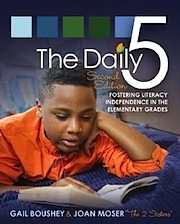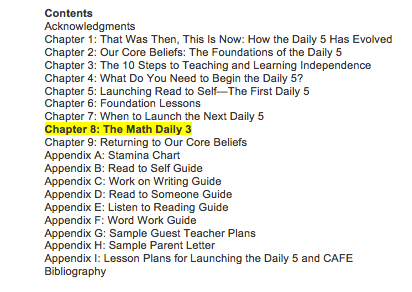Impressive Guide to a Powerful Literacy Strategy
The Daily 5: Fostering Literacy Independence in the Elementary Grades (2nd Edition)
Gail Boushey and Joann Moser
(Stenhouse, 2014 – Learn more)

I have to admit it. Using the Daily 5 is new to me, and I have been teaching for many years. I’ve heard colleagues from other districts talk about their success with the Daily Five and wondered why their eyes lit up when they spoke about this literacy strategy. It was like a mantra.
When I first started to read the book, I thought….okay, another management system for the students to learn. However, as I continued on, I realized that it was a structure based on Best Practices: modeling, students working on authentic reading tasks, reflection, and meaningful instruction tailored to meet the individual needs of students.
I am glad I had a chance to review this book and learn a bit more about how the Daily Five can help drive literacy learning in the upper elementary grades.
The essentials

The 5 components are:
- Read to Self (reading self selected materials independently)
- Read to someone (reading aloud with a partner while practicing strategies and fluency)
- Listen to Reading (hearing good models of fluent reading)
- Work on writing (practicing writing fluency)
- Word Work (phonics and spelling/vocabulary practice)
The sisters build these components on a foundation they call the 10 Steps to Teaching and Learning Independence. As I read the book, I realized that objectives of The Daily Five are consistent with the readers and writers workshop methods. We want students to build stamina and independence; we want to provide students with choice in authentic reading and writing experiences and find time to confer with students. We want kids to ENJOY READING AND WRITING!
What impressed me was the consistency of routine, almost automatic differentiation, and the amount of time built into the Daily Five literacy block to build stamina for longer periods of reading and writing.
Teachers always struggle with finding sufficient time to teach while maintaining student interest. The Daily 5 teaches students how to manage their own learning and to be responsible citizens in the classroom. The literacy block becomes a time for students meet in small groups with focused teaching as well as do whole group presentation.
Nugget hunting: The Math Daily 3?!
Since I am being honest, I have to admit I didn’t follow the book chapter by chapter. There was so much in the book that I wanted to read — nine chapters and nine appendices. I am more of an “I want to see everything all at once” reader. So I immediately set out to hunt for nuggets and the answer to a popular teacher question: “What freebies/handouts are in the book that I can copy?”.
Immediately, Chapter 8 – Math Daily 3 caught my interest

“Given the success of Daily 5 during literacy, we began to use the 10 Steps to Teaching and Learning Independence in almost everything we did” (p.122).
It made sense. As educators, we want to gradually untie the learning apron strings and give students a chance to explore their learning, take ownership, and excel.
The Math Daily 3 evolved as:
- Math by myself
- Math Writing
- Math with someone
The Common Core Standards require students to think and learn in a much deeper way in all subject areas, all the time, and the Math Daily 3 meets this expectation. Math writing assignments are built with the brain in mind and linked to help students learn the subject matter at hand, whether it is an open ended question or explaining a complex algebraic function. That is, lessons are built with direct teaching, choice, gradual release of responsibility, movement and student participation. What could be more perfect than that?
Two teachers who love teaching
I have never met “the Two Sisters,” but from reading their book I know that each word, page, and chapter was written with a genuine love of teaching. The book does not preach to you about the benefits of the Daily 5 or Math Daily 3, but guides you to discovering the benefits within this structure for yourself, as you consider how you could adapt it to your classroom.
Boushey and Moser were honest from the beginning. This edition was written after reflecting on the original publication. They looked into Daily 5 classrooms and asked for input from educators to determine what worked well and what needed to be modified. In doing so, they modeled reflection and continuous improvement — what every teacher’s practice should be about.
Start reading now for next year
I would recommend reading this book before school starts in the fall, bit by bit from front to back (not like I did, speed reading with a pogo stick). Take notes and think about how you can integrate the Daily 5/Math Daily 3 into your classroom when school begins. If these strategies appeal to you, then it’s likely you already have the major components in place in your classroom: trust, choice, community, and stamina. All you may need is the structure.
This book will guide you step-by-step. Page by page, it will answer any questions that you have. Each chapter is another adventure into enjoyable classroom planning and lesson design. By the time you reach the last page, you are ready to “Give it a Go” and build a stronger ELA and math literacy program.
Enjoy your reading and the Daily 5!
Linda Biondi is a fourth grade teacher at Pond Road Middle School in Robbinsville, NJ, and a recipient of several educational grants that infuse a literacy enriched curriculum with an understanding of individual learning styles to help students understand bias and patterns of discrimination. She is a Teacher Consultant with the National Writing Project and a participant on the NJ Department of Education Teacher Advisory Panel.



































